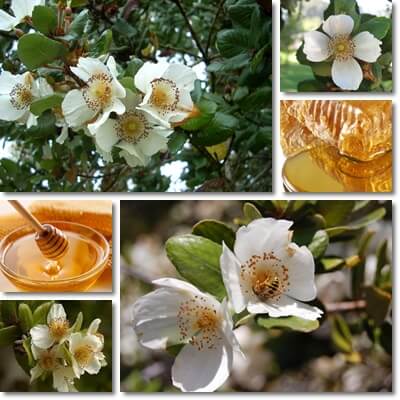Ulmo honey is a rare variety of monofloral honey made from the flower nectar and pollen of ulmo trees from the species Eucryphia cordifolia, from Argentina and Chile. Studies show ulmo tree honey exhibits a strong antibacterial action against antibiotic-resistant strains of bacteria such as Escherichia coli and Staphylococcus aureus. Furthermore, the honey exhibits antinfungal activity, tonic properties, aids in the treatment of respiratory tract infection symptoms such as cough or sore throat, helps combat fatigue and offers digestive benefits.
Ulmo trees of the species Eucryphia cordifolia are rare and limited to the South American Andes, a range of mountains in the western part of the continent. Argentina and Chile currently have the biggest populations of the tree species. A great majority of the honey is produced in Chile, where there are sufficient tree specimens to feed bee colonies and support honey production. Ulmo trees are in blossom from February until the end of April and generally produce four-petaled white flowers rich in a sweet and fragrant nectar that honey bees collect and use as sustenance and for honey production.

The economic and ecological impact of ulmo tree honey. Ulmo honey is appreciated not only for its nutritional value and health benefits, but also for its positive economic and ecological impact. Ulmo wood is aimed at by the logging industry because of its resistance and appearance, which threatens the very existence of the species. The rise in popularity of ulmo honey, which imparts a different economic importance to the tree species, is currently the single biggest deterrent to excessive logging and a means to preserve the species. By giving it economic significance and helping propagate the species via pollination by honey bees, ulmo honey production has a positive ecological impact.
What does ulmo honey look like? The variety generally has a light amber color (a cloudy-milky yellow) and is opaque, a characteristic that is a direct result of its thick, creamy, curd-like consistency (think about lemon curd or orange curd).
What does ulmo honey taste and smell like? Ulmo tree is quite a fragrant, aromatic honey. It has an exquisite flavor profile, reminiscent of the sweet, fragrant ulmo flower nectar. It has a particularly sweet taste, strong floral notes and a slight astringent, minty-fresh aftertaste. However, climate, weather conditions, amount of rainfall, temperature and other factors directly influence ulmo nectar collection by honey bees and subsequent honey production, potentially resulting in more or less significant differences in the taste and appearance of the honey. As a result, it is possible that both the taste and appearance of ulmo honey may not be constant over time.

What about the benefits?
What are the health benefits of ulmo honey? In certain respects, the properties of ulmo honey are comparable to those of the famous Manuka honey. Here are 9 of the most impressive uses and health effects of ulmo honey:
1) Antibacterial and antibiotic properties. Ulmo honey is a strong natural antibacterial and antibiotic and owes such properties primarily to its content of hydrogen peroxide, a natural antimicrobial found in all honey varieties. The low moisture content and low pH of the honey also contribute to such effects, limiting bacteria spread and reducing bacteria numbers. Research shows ulmo honey to be efficient against antibiotic-resistant bacteria strains such as E. coli, S. aureus or P. aeruginosa (Comparison of the antimicrobial activity of Ulmo honey from Chile and Manuka honey against methicillin-resistant Staphylococcus aureus, Escherichia coli and Pseudomonas aeruginosa).
Furthermore, like all honeys, ulmo too contains varying amounts of plant pollen which has been shown to boast immunomodulating properties, meaning it stimulates the immune system response against infection and disease. But in addition to boosting immunity, pollen is also a cause for allergy. Anyone with ulmo pollen or multiple pollen allergies should avoid ulmo honey. Also, anyone allergic to honey bee enzymes used for the production of honey should avoid honey in general and all its byproducts (bee bread, royal jelly and so on).
2) Promotes fast wound healing. As a result of its strong antibacterial, antiseptic, antibiotic and antifungal properties, ulmo honey is believed to promote faster wound healing for skin injuries, cuts or breaks in the skin, scratches, even insect bites, ulcers, burns, blemishes and acne scars or varicose (vascular, venous) ulcers. However, just smearing the honey on the skin will not heal a wound because specific preparations with certain concentrations are required for such effects, so seek immediate medical help for wound treatment.
3) Good for gastritis and stomach ulcers. Ulmo honey is eaten on an empty stomach in the morning to help treat stomach ulcers and gastritis. The antibacterial action and soothing effect of the honey are believed to protect the stomach lining and encourage it to heal. It is recommended to avoid eating and drinking up to an hour afterwards and continue eating the honey for several weeks. However, remember that the honey does not replace prescription medication or a strict gastritis diet, so talk to your doctor about the possibility of including it in your diet as an alternative, complementary treatment option.
4) Natural remedy for cough and sore throat. Ulmo honey is a great natural remedy for respiratory tract infections, helping both combat infection and improve symptoms. The variety helps calm cough and relieves sore throat discomfort by creating a sort of protective coating over the throat lining, preventing further inflammation and allowing it to heal. It is recommended to eat one tablespoon of honey 4-5 times a day and avoid eating or drinking for up to an hour after taking it.
5) Boasts mild prebiotic properties. Ulmo honey is rich in natural sugars that help feed the good bacteria in our digestive tract, hence its prebiotic properties and contribution to digestive health.
6) Helps combat fatigue and hypoglycemia. The variety is a great natural tonic that improves energy levels and stimulates appetite and, due to its energizing properties, combats fatigue and hypoglycemia.
7) Source of vitamins and other nutrients. Like all honeys, ulmo too contains trace amounts of vitamins and minerals such as vitamin C, B vitamins, potassium, calcium, iron, magnesium, phosphorus and others. In addition to this, its nutritional profile is enriched by the presence of small amounts of other types of nutrients, notably amino acids, pollen, propolis, various enzymes and other particles with nutritional value. All of these elements contribute to the nutritional value of honey.
8) Good for acne and uneven skin tone. Honeys with a strong antibacterial action like ulmo can help reduce acne breakouts by reducing bacteria numbers on the skin (bacteria cause infection that triggers acne). The raw, unprocessed, unheated honey has to be applied on the clean face, left to act for 20 minutes, then washed with lukewarm water. If used consistently, this natural remedy can have other benefits as well. For example, applying a honey face mask every other day can help unclog pores, reduce blackheads and make skin soft and radiant. Moreover, light-colored honeys like ulmo are good for uneven skin tone as well. Their gentle exfoliating effect (especially if they are thicker or starting to crystallize) accentuates the benefits.
9) Antioxidant action. Last but not least, ulmo honey is a source of antioxidants, including polyphenols, notably flavonoids. Antioxidants protect our cells from the harmful action of reactive oxygen molecules called free radicals, preventing excessive oxidative stress that can cause inflammation and disease. More recent research has linked oxidative stress and high inflammation levels in the body to the onset of chronic disease (cancer, nerve diseases and others).
Conclusion
Ulmo honey is an exquisite and fragrant monofloral honey with great benefits on the respiratory, digestive and immune systems. Furthermore, it has a positive impact on energy levels and appetite and promotes skin health. However, in order to enjoy all the benefits it has to offer, the honey needs to be consumed raw, unheated and unprocessed in any way (check the label). Fortunately, considering that the variety is still produced using traditional methods, which nonetheless accounts for its higher price and poor availability, most of the ulmo honey marketed is raw and organic, and thus healthy and good for us.
